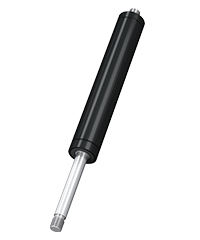
A sailplane, or glider, is an unpowered gliding aircraft often used for sport or leisure that relies on currents of rising air in order to soar. Thanks to its aerodynamically streamlined design, a sailplane can fly in a forward direction with just a small drop in altitude.
To change motion, the pilot uses a bell crank to control the sailplane’s glide angle. The angle can be from 0 to 360 degrees, although 90 and 180 degrees are most commonly used. Recently, a sailplane builder tested a bell crank that produced a challenging response curve on a graph — indicating an impact load. The curve showed that without damping, the bell crank provided high, but not constant, acceleration due to forces in the bell crank increasing as a function of linear displacement. The sailplane builder needed a damping device to restrict the angular velocity of the bell crank in order to change the required displacement over time to produce a satisfactory response curve. To achieve this displacement response, the average response should be about 0.224 miles per hour.
A Top-Flight Gas Spring for Sailplanes
To better control linear displacement, the builder installed an ACE Controls GS-28-300 push-type gas spring. This unit is part of our industrial gas spring line, which can support forces ranging from 2 to 2,923 pounds and comes with body diameters from 0.31 to 2.76 inches. The GS-28-300 has a stroke up to 11.81 inches, and the extension force rating of approximately 2,500 Newtons is more than enough to handle the sailplane builder’s requirement of 700 Newtons.
With the GS-28-300 installed into the glider structure, the bell crank can maintain an acceleration as close as possible to zero. And, the response curve is now constant without any peaks. The builder also benefits from the gas spring’s maintenance-free operation, thanks to an integrated grease chamber that reduces friction and wear and optimizes lubrication. We also provided online sizing and configuration tools to ensure a perfect-fitting unit.
Additional features include:
- Ready for installation and pre-filled with pressurized nitrogen gas.
- An integrated valve for easy adjustments.
- Ease of installation, thanks to mounting points.
- A variety of accessories.
Stable Motion for a Steady Glide
When it comes to controlling a sailplane’s acceleration and glide angle, the right gas spring can make a difference. Our industrial gas springs offer the force handling capability to help a sailplane builder’s bell crank assembly achieve the stable linear displacement required for a steady glide.
For more information about ACE Controls’ GS-28-300 industrial gas springs, visit our product page.


